

“Portraits of the Passion: Pieta”
John 19:17-42
Pastor Kevin Vogts
Trinity Lutheran Church
Paola, Kansas
Lent Service V—March 25, 2020
In the Name of the Father and of the Son and of the Holy
Spirit. Amen.
Today is actually a major traditional holy day in the Christian church
year. Because, if you count back nine months from December 25th, when we
celebrate the birth of Christ, you come to today, March 25th, when the church
traditionally observes The Annunciation of Our Lord, the angel Gabriel appearing
to Mary and announcing, “You will be with child and give birth to a Son, and you
are to give him the name Jesus.”
Though it is an important Christian holy day, The Annunciation is not
widely observed because it almost always falls during Lent. So, this
evening for our Lenten sermon series “Portraits of the Passion” we consider an
extremely popular genre in Christian art of the Middle Ages and Renaissance,
featuring Christ and his mother Mary, the image called the “Pieta.”
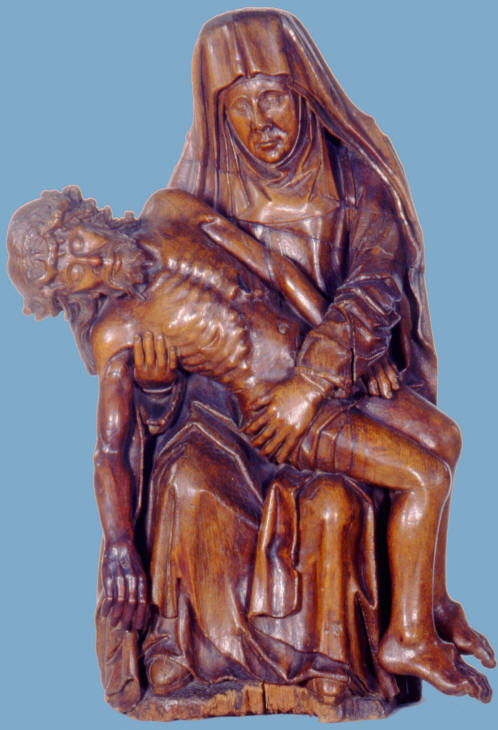
“Pieta”
Anonymous – Flemish – 1400’s – Carved Oak
The word “Pieta” comes from the Latin word for “pity.” The Pieta
shows Jesus’ mother Mary “pitying,” mourning her dead son,
cradling his lifeless
body in her arms. The Pieta portrays the fulfillment of Simeon’s prophecy
to Mary some 33 years earlier, when he was but a baby she held in her arms: “And
a sword will pierce your own soul also.” The most famous Pieta is a
life-size marble sculpture by Michelangelo. This Flemish Pieta from the 1400’s on display at the Spencer Museum of Art is also very large and
impressive, several feet high and beautifully carved out of oak.
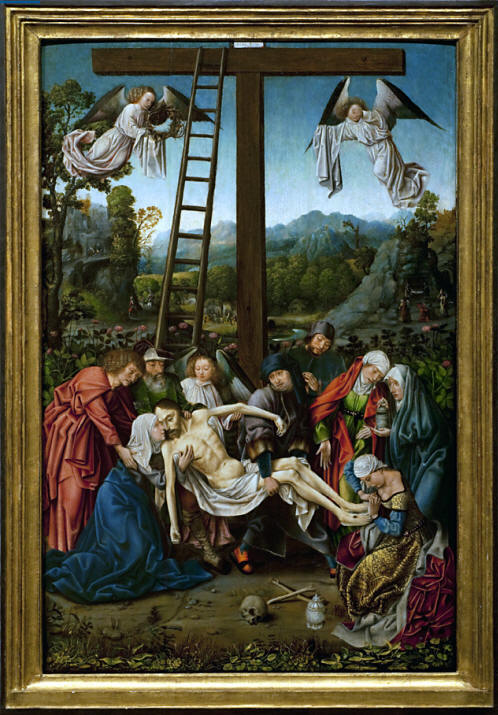
“Descent from the Cross”
Workshop of the Master of Frankfurt – 1500’s – Oil on Oak Panels
The Pieta had its origin in another favorite genre from the Middle Ages
and Renaissance, “The Descent from the Cross.” As seen in this center
panel from a German altar triptych from the 1500’s, “The Descent from the Cross”
shows the scene at Mt. Calvary after Christ’s death, as his body is lowered for
entombment. As part of this genre, it was customary to show Christ’s
lifeless body being lovingly held by his mourning mother at the base of the
cross. Eventually, this scene from “The Descent from the Cross” developed
into a favorite artwork in its own right, and the Pieta was created.
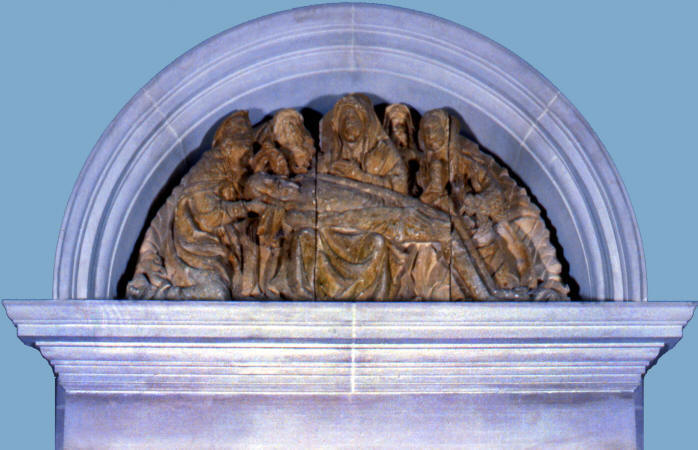
“Tympanum with the
Lamentation”
Simon and Franciso de Colonia – Spanish – 1500 – Stone
The dramatic and moving Pieta became so popular that the Spencer Museum
in Lawrence has all sorts of examples in different sizes and media. This
enormous example is above the main entrance to the museum in the central court.
Mounted as it would have been originally, this impressive carved stone Pieta
from the 1500’s is an architectural element called a tympanum, designed to be above a door, and was
originally part of a Spanish monastery.
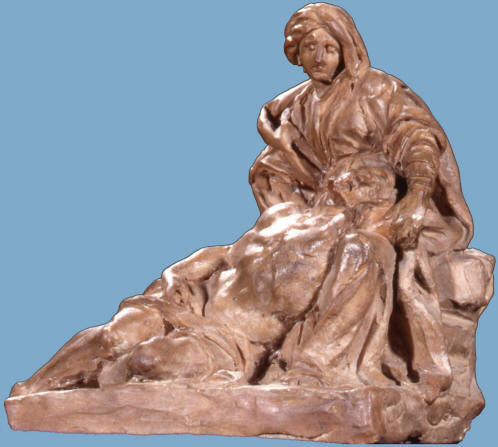
“Pieta”
Egid Quirin Asam – German – 1725 – Terra Cotta
In contrast, this delicate German terracotta Pieta from the 1700’s is
just about eight inches tall.
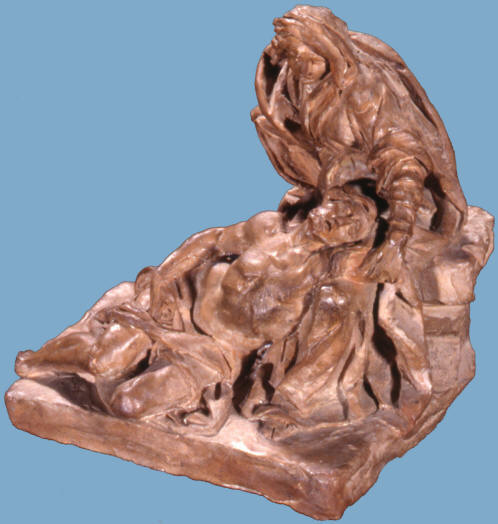
“Pieta”
Egid Quirin Asam – German – 1725 – Terra Cotta
In another view of the same work, you can see one reason why the Pieta
was favored by Renaissance artists. At a time when art was starting to
become more realistic, like the studies of human models done by art students
today,
the Pieta gave artists an opportunity, sanctioned and supported by the Church,
to artistically explore the intricacies of human anatomy, and realistically
portray a human figure, in the person of Jesus Christ.
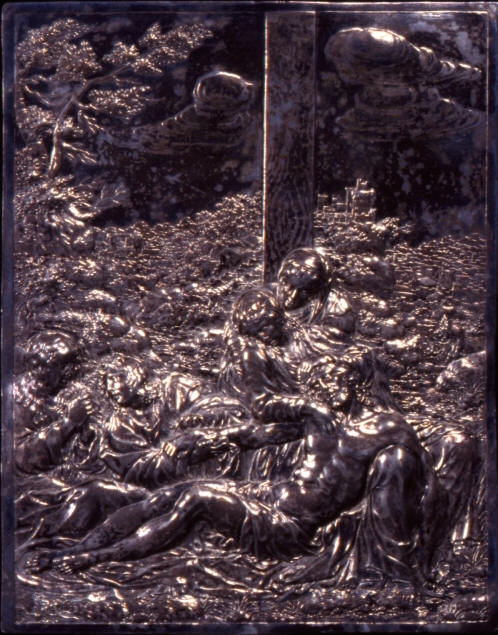
“The Lamentation”
Augsburg Germany – 1625 – Silver Repoussť
This German silver plaque from the 1600’s is made by a process called
repoussť, hammering in the image from the back. It shows the
Pieta beautifully portrayed in yet another medium.
What is the theological significance of the Pieta? The Pieta
dramatically stresses through art a very important Biblical doctrine, the true
humanity and real physical suffering and death of Jesus Christ. As St.
Paul says in 1st Timothy, “Beyond all question, the mystery of godliness is
great: He appeared in a body.”
St. John’s Gospel says, of the divine Son of God before he became a
man, “In the beginning was the Word, and the Word was with God, and the Word was
God,” and then it continues, “And the Word became flesh and dwelt among us, and
we beheld his glory, the glory as of the only begotten of the Father, full of
grace and truth.”
Jesus Christ did not merely have the appearance of a human, and he did
not merely pretend to die. Scripture teaches that he truly was both God
and man, and that on Good Friday GOD shed his blood and GOD died upon the cross
as payment for our sins. As St. Paul says in Colossians, “For in Christ
all the fullness of the Deity lives in bodily form. . . For God was
pleased to have all his fullness dwell in him, and through him to reconcile to
himself all things . . . by making peace through his blood, shed on the cross.”
In the Pieta we have a powerful testimony to this Scriptural truth, the
true humanity, and real physical suffering and death, of Jesus Christ. As
Hebrews says, “We have been made holy through the sacrifice of the body of Jesus
Christ once for all.”
Return to Top | Return to Sermons | Home | Email Church Office